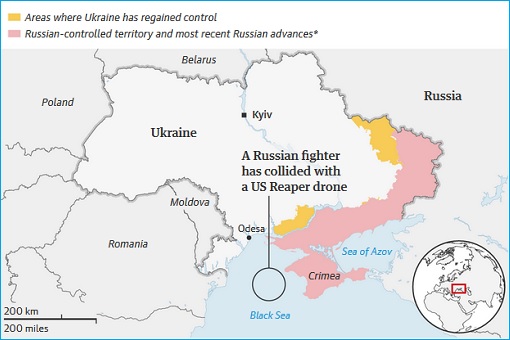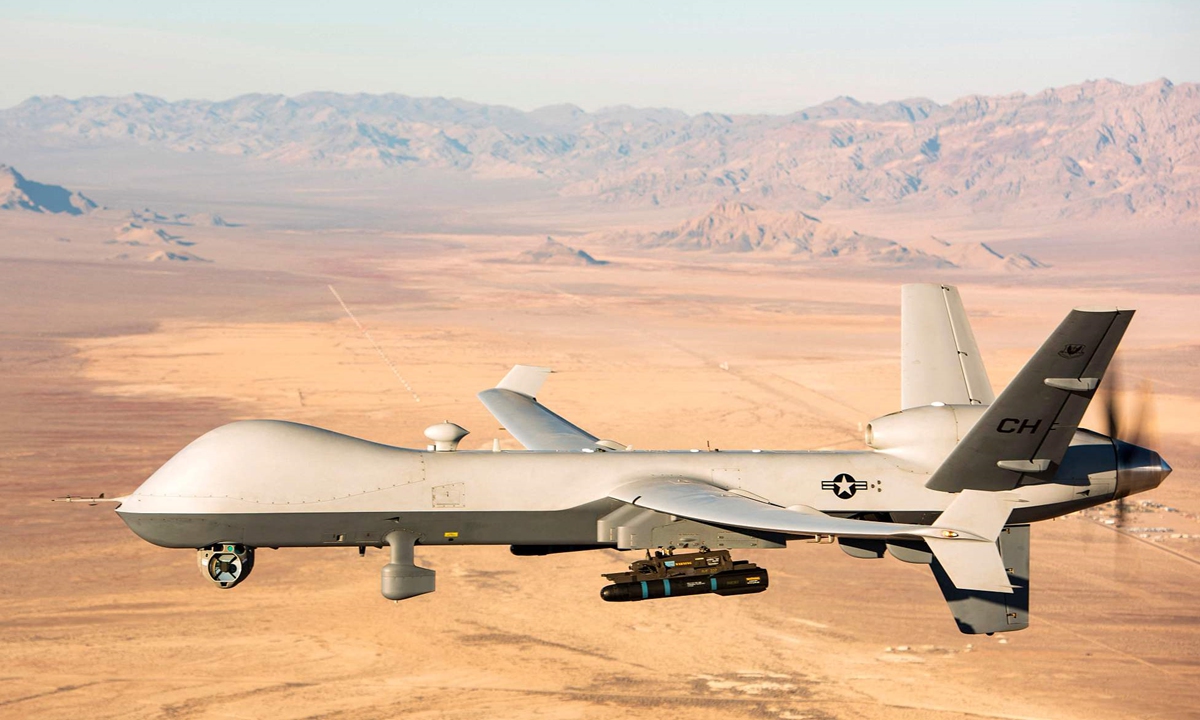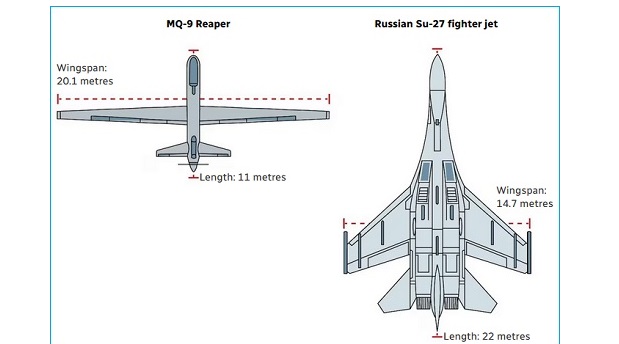TOP GUN, MY FOOT! – ANOTHER U.S. AIR FIASCO AS RUSSIA SHOWS HOW TO DEFEAT PENTAGON’S US$30 MIL SUPER-DEADLY DRONE WITHOUT EVEN FIRING A SHOT – WHILE EVEN CHINA CAN’T RESIST MOCKING A WASHINGTON, CAUGHT RED-HANDED TRYING TO HELP UKRAINE ATTACK RUSSIA & TELLING LIES BY SNIPPING 60 SECONDS OFF AN OFFICAL VIDEO – ‘WHY IS IT ALWAYS U.S. MILITARY PLANES THAT RUN INTO ‘ACCIDENTS’?’
U.S. Reaper Drone Down – Russia Shows How The $30 Million Deadly Drone Could Be Easily Defeated Without Firing A Shot
Costing US$32 million a pop, the U.S. Air Force MQ-9 Reaper drone can be armed with a variety of weaponry, including up to eight laser-guided Air-to-Ground Missile-114 Hellfire. Also known as “Predator B”, the unmanned aerial vehicle (UAV) can loiter at up to 50,000 feet for more than 27 hours, gathering intelligence with sophisticated cameras, sensors and radars.
The Reaper, therefore, provides a unique capability to perform strike, coordination, and reconnaissance against high-value and time-sensitive targets. It is a great candidate to perform missions like intelligence, surveillance and reconnaissance, close air support, combat search and rescue, precision strike, convoy and raid overwatch, route clearance, and terminal air guidance.
On Tuesday (March 14), the U.S. lost one of them over the Black Sea. Pentagon said two Russian Su-27 fighter jets had intercepted its “surveillance” drone, which was flying in the international airspace. One of the Russian jets was accused of intentionally flying in front of the Reaper and dumped fuel on the drone several times, before colliding with the American drone.
The U.S., obviously upset, has claimed the Su-27 fighter jet struck and hit the propeller of its deadly and expensive drone, causing it to crash in international waters southwest of Crimea. Pentagon has also condemned the Russian pilot of behaving in a “reckless, environmentally unsound and unprofessional manner.” However, Russia had given a different version of events.
The Russian Ministry of Defense said that the American drone had been flying near the Russian-occupied Crimean Peninsula and was headed toward the Russian border with its “transponder switched off”. Two Russian Su-27 fighter jets were scrambled to intercept the “unidentified” drone. Exactly why was the U.S. drone flying thousands of miles away from home near the Russian border?
Had Russia or China sent a military spy drone capable of unleashing air-to-surface missiles near Los Angeles, the U.S. would have shot it down. Make no mistake – the Russian Su-27 jets were more than capable of shooting down the Reaper. But doing so will be an act of war. At the same time, the nuisance, which has been going on for a very long time, cannot be ignored.
While Moscow has denied Washington’s accusations that its jets acted recklessly, it did not mention anything about the naughty act of dumping fuel on the drone. Instead, it has blamed “sharp manoeuvring” by the drone for the crash, claiming its jet did not make contact. Both the U.S. and Russia acknowledged that no weapons were used during the downing of the drone.
Today, the U.S. Department of Defence released a 40-second declassified video clip in an attempt to prove that the Russian Sukhoi Su-27 was responsible for the crash of its drone. The video was from a camera on the MQ-9 Reaper drone being pointed backward toward its tail and propeller. A Russian jet can be seen approaching the rear of the drone and began releasing fuel.
Suspiciously, the video feed was briefly disrupted as the Russian jet was passing over the drone, presuming continuously dumping the fuel. The propeller appeared to be in working condition and undamaged when the video feed resumed. When the jet came back for another approach, once again releasing fuel, the video feed was suddenly cut by 60 seconds.
Not only you need a Russian pilot with balls of steel to commit suicide by hitting the drone with his own jet, but it’s also impossible to do so without suffering considerable damage to the Su-27. Every fighter jet’s nose is packed with expensive, sensitive and fragile electronics such as radar and sensors. It’s not a truck that can be used to ram into a drone with a weight of about 4.5 tonnes.
At most, the U.S. can accuse Russia of harassing its drone by dumping fuel to blind its optical instruments and drive it out of the area. Besides, why didn’t the Pentagon show the entire video-clip of the incident without resorting to cutting here and there to suit their purpose? The U.S. has to prove that the Russian jet had come into contact and collided with its drone and damaged its propeller.
Washington can easily use the incident as an excuse to extract concessions from Moscow, or even launch a military strike at Russia. On June 20, 2019, Iran shot down a U.S. RQ-4A Global Hawk surveillance drone. In retaliation, U.S. President Donald Trump ordered a military strike against Islamic Revolutionary Guard Corps (IRGC) radar and missile sites, only to reverse the decision.
Instead, the U.S. retaliated with cyberattacks on the IRGC’s missile-control systems and announced new sanctions. The fact that President Joe Biden dares not retaliate militarily against President Vladimir Putin suggests that the U.S. can only afford to bully small nations, but not against military power like Russia. To save face, Washington has to accept that it was just “an accident”.

Still, America cannot explain why its drone was flying with its transponders turned off, if indeed “hunter killer” MQ-9 Reaper had no intention to violate the Russian airspace. Transponders are communications devices that allow the aircraft to be tracked. The U.S. used to accuse Russian ships of switching off their transponders to illegally deliver oil to Syria.
Besides, if the mission was reconnaissance and not to help Ukraine attack Russian territory, why can’t the U.S. Air Force use its Global Hawk drone, which was designed for purely long-range surveillance purpose? It can survey as much as 40,000 square miles (100,000 km2) of terrain per day, an area the size of South Korea or Iceland.
The Pentagon knew Russia had imposed flight restrictions in the area of the Black Sea because of its military operations in Ukraine, but still ignored it with a deliberate provocation. If the Kremlin wanted to, it could shoot down the drone and use the excuse that its transponders were turned off as a cover. And there’s nothing the U.S. can do unless it declares World War 3 with Russia.
More importantly, Russia has shown to its allies China and Iran how to bring down the Predator drone without firing a single shot. Unlike the American Air Force, who burned US$400,000 on supersonic infrared heat-seeking air-to-air missile Sidewinder to shoot down some harmless UFOs and balloon, it’s cheaper to crash the General Atomics MQ-9 Reaper with some fuel. FINANCE TWITTER
Why it is always US military plane that runs into ‘accident’: Global Times editorial

File photo of an MQ-9 Reaper drone. Photo: VCG
On Tuesday local time, a US military drone crashed over the Black Sea, which made the whole world nervous. People’s first reaction was not to discuss who is responsible, but fear. Some media said that this underlines “the risk of direct confrontation” between the US and Russia since the outbreak of the Russia-Ukraine conflict. It may be inaccurate to say so, but it reflects the high degree of international public opinion’s attention to this incident. The direct consequence of the incident is that it brought the tension on the Russia-Ukraine battlefield to the highest level since the conflict broke out, and may trigger an unexpected escalation of reactions. This is obviously something the whole world does not want to see.
The US military lost an Air Force MQ-9 Reaper drone this time, and there were no casualties. The US and Russia disagree on how it fell. Moscow says it “did not use airborne weapons” on this occasion. It also claims its jet “did not come into contact” with the Reaper and the crash was a result of “sharp maneuvering.” The US military said a Russian fighter jet had dumped fuel on an American drone over the Black Sea and then collided with it on Tuesday, causing the drone to crash. The US State Department has expressed its concerns about the incident to the Russian side. It may be that the US knows itself is partly to blame. The attitude of the US side is not too drastic. It is worth noting that the Reaper drone has repeatedly performed surveillance and precision strike missions in US military operations. It was this drone that was used by the Trump administration to assassinate Iranian top general Qasem Soleimani. Regarding the drone that crashed in the Black Sea airspace this time, US officials were not willing to disclose whether it was armed.
The matter is under control and we hope the US and Russia can handle it rationally. Judging from the current reaction, neither Moscow nor Washington wants to escalate the crisis. It must be said that the tense situation in the region cannot withstand several incidents like this. It is like two people smashing rocks next to a pile of explosives. Who can guarantee that there will be no sparks, or that the sparks will not detonate the explosives? This incident should not just end in the mutual accusations between the US and Russia, but should arouse the vigilance of the two sides, especially the US, and become an opportunity for both parties to rebuild a crisis management and control mechanism.
The Cuban Missile Crisis during the Cold War shocked the world, but there was no such a crisis after that, because both the US and the Soviet Union fully realized that such an incident is too dangerous to be allowed to happen again. On the basis of this rare and important consensus, the US and the Soviet Union each took a step back, and then launched nuclear arms control negotiations, so that the “Cold War” did not turn into a destructive “hot war.”
Of course, this drone crash cannot be compared with the Cuban Missile Crisis, but some laws and logic are common. Today, Washington is pushing for major power confrontation again, dragging the world to the brink of a new Cold War, and the possibility of catastrophic consequences is increasing little by little. Just after the encounter between US and Russian military planes in the Black Sea, US National Security Council spokesperson John Kirby said it was “not uncommon” for Russian aircraft to intercept US aircraft over the Black Sea, which shows Washington is used to such “encounters.”
The crash of the US military drone is an accidental event, but its occurrence has certain inevitability. After the end of the Cold War, similar incidents of military plane encounters, accidental crashes, and even jets being shot down happened many times, some of which seriously exacerbated regional tensions, and most of them were related to the US military. And its targets were often countries that Washington publicly regards as imaginary enemies. This is very telling. As the US conducts more and more military operations overseas, the frequency of its extreme provocations is also increasing. Meanwhile, the atmosphere of major power relations has been severely worsened, and bilateral constraints, exchanges and communication mechanisms such as Nuclear Arms Control Treaties have been severely damaged. Under such circumstances, the probability of misfires that would lead to the escalation and even loss of control of the situation is rising. There are constant reminders of emergencies that cannot be ignored.
Peace is so fragile, and crisis management is important, but reducing its occurrence from the root is even more critical. There is urgency to avoid a war that neither side wants to fight. This month marks the 20th anniversary of the US launching the Iraq War, and 20 years should be enough for the US and the international community to reflect deeply. As the Guardian said, “every time something like this happens, the world uses up a little bit more of its luck.” Peace and stability of the world obviously cannot always rely on “luck.” – GLOBAL TIMES
FINANCE TWITTER / GLOBAL TIMES
.
